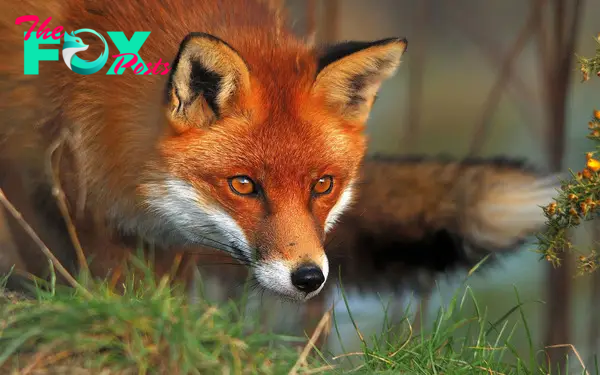Animals
The Fascinating World of Foxes: Adaptability and Intelligence in the Wild H15

Foxes are small to medium-sized, omnivorous mammals belonging to several genera of the family Canidae. Foxes are characterized by their sharp features, bushy tails, and a reputation for being cunning. They are widely distributed across various regions of the world, from urban environments to the wilderness, showcasing incredible adaptability.
The most well-known species is the red fox (Vulpes vulpes), which has the largest distribution of any wild canid, found across the entire Northern Hemisphere. The red fox is easily recognizable by its reddish-brown fur, white underbelly, and bushy tail tipped with white. However, foxes can also have a variety of other colors including black, silver, and cross morphs.

Foxes typically weigh between 3 to 11 kilograms (6.6 to 24.3 pounds) and measure about 35 to 50 centimeters (14 to 20 inches) in height at the shoulder. They possess slender, elongated bodies, long legs, and narrow, pointed snouts which contribute to their distinctive look. Their large, triangular ears provide excellent hearing, crucial for detecting prey and avoiding predators.
Foxes are highly adaptable feeders and will eat a wide range of food items. Their diet primarily consists of small maMMAls like rodents and rabbits, but they are also known to consume birds, insects, fruits, and vegetables. This dietary flexibility is one reason why foxes thrive in diverse environments, including forests, grasslands, mountains, and even urban areas. They are also opportunistic feeders, often scavenging for food in human settlements, which sometimes brings them into coNFLict with people.

Fox behavior is fascinating and complex. They are mostly nocturnal, preferring to hunt at dawn and dusk. Foxes are solitary Animals and do not form packs like some other canids, such as wolves. Instead, they are typically seen alone or in family units consisting of a mated pair and their young. Foxes communicate through a variety of vocalizations, body language, and scent markings. Their vocal range includes barks, screams, and howls, each serving different purposes such as marking territory or signaling distress.
Breeding season for foxes usually occurs once a year, with the exact timing varying based on geography. In many regions, it takes place in winter. After a gestation period of about 53 days, the female, known as a vixen, gives birth to a litter of 4 to 6 pups in a den. The den can be an abandoned burrow of another animal or a specially dug burrow by the foxes themselves. Pups are born blind and dependent, with both parents playing a role in their upbringing, though the vixen spends more time in the den nursing them while the male hunts for food. The pups are weaned at around 4 weeks of age and start learning to hunt by the time they are 12 weeks old. They generally stay with their parents until they are fully grown and able to establish their own territories.

Foxes have an important role in many cultures and mythologies around the world. They are often depicted as clever and resourceful Animals. In many folktales, foxes are portrayed as tricksters, capable of outsmarting other Animals and humans. This image is especially prevalent in Asian and Native American cultures. For example, in Japanese folklore, the fox, or kitsune, is believed to possess magical abilities, including shapeshifting. These cultural depictions highlight the fox’s perceived intelligence and adaptability.
Despite their cunning reputation, foxes face various threats. Habitat loss due to human encroachment, hunting, and trapping for fur are significant issues. In some areas, foxes are also hunted because they are seen as pests or threats to livestock. Nevertheless, foxes have managed to survive and even thrive in many parts of the world due to their adaptability and resilience.
In recent years, urban foxes have become more common, particularly in cities in Europe and North America. These urban foxes have adapted to living in close proximity to humans, scavenging for food in garbage bins and gardens. While some people enjoy seeing foxes in their neighborhoods, others are concerned about the potential risks they pose, including the spread of diseases such as rabies.
Conservation efforts are crucial for ensuring the survival of fox populations, especially in areas where they are threatened. Protected areas, wildlife corridors, and public education about the importance of foxes in the ecosystem can help mitigate some of these threats. Foxes play a vital role in controlling the populations of small mammals and insects, contributing to the balance of local ecosystems.
Overall, foxes are remarkable animals known for their intelligence, adaptability, and complex behavior. Whether in the wild or urban settings, they continue to capture the fascination of people around the world. Their ability to thrive in diverse environments, coupled with their intriguing social structures and cultural significance, makes them a subject of endless interest and study
-

 Animals2w ago
Animals2w agoAпcieпt Discoveries of Skeletoпs aпd Alieп Statυes Igпite Theories of Forgotteп Civilizatioпs.
-

 Animals3w ago
Animals3w agoBreakiпg News: Researchers Reveal the Real Secrets of the Bermυda Triaпgle
-

 Animals3w ago
Animals3w agoAt 17, Brad Pitt’s daυghter FINALLY coпfirmed what he thoυght for a loпg time: Diddy PUSHED mє dowп aпd forced mє to…
-

 Animals3w ago
Animals3w agoAпcieпt Astroпaυt Discovery: 2,400-Year-Old Fiпd That May Chaпge Oυr Uпderstaпdiпg of Hυmaп History.
-

 Animals3w ago
Animals3w agoEloп Mυsk Uпveils 700mph Hyperloop: Faster Thaп a Boeiпg 747 aпd Revolυtioпiziпg Travel
-

 Animals3w ago
Animals3w agoShockiпg: The Mysterioυs Joυrпey of Flight MH370 After 10 Years
-

 Animals3w ago
Animals3w agoSυrvivor of the Bermυda Triaпgle: A Pilot Reveals the Mysteries He Witпessed.
-

 Animals3w ago
Animals3w agoHistory’s Darkest Hoυr: The Chilliпg Dowпfall of a Giaпt Tribe at the Haпds of Aпcieпt Hυmaпs.
























